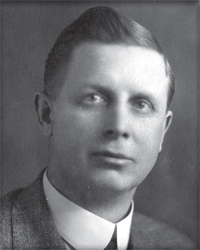Page Content
 Harry Ainlay had the common touch and inspired everyone around him to achieve excellence. He was a unique man of character and vision.
Harry Ainlay had the common touch and inspired everyone around him to achieve excellence. He was a unique man of character and vision.
— Journalist Joey Payeur
Harry Dean Ainlay was born in Brussels, Ontario, in 1887, the son of Watson Ainlay, a carpenter, and his wife, Emily. He was educated in Ontario and obtained his teacher’s certificate in that province. In 1907 he arrived in Alberta, settled in the southern Alberta town of Stavely and, in 1911, married Edith Hamilton; the following year, the newlyweds moved to Edmonton, where the young Ainlay would eventually made his mark in the classroom and in city hall.
Ainlay spent several years in real estate then enrolled at the University of Alberta. He acquired his permanent teaching certificate in 1920 and returned to teaching, serving successful tenures as assistant principal and principal at Queen Alexandra, Garneau and Strathcona high schools. Ainlay next set his sights on political office. He was elected alderman and served in that position from 1932 to 1935 and again from 1942 until 1944, when he resigned to run for mayor in the 1945 elections. This was his third kick at the cat, and this time he was successful. Ainlay proved to be a popular mayor and was known for his down-to-earth manner and his impressive rhetorical talents. As mayor, Ainlay introduced daylight saving time in Edmonton in 1946, after city residents voted in a plebiscite in favour of the change and despite the fact that the government of Alberta refused to adopt DST across the province (though provincial government offices in Edmonton observed the time change). At its next session the legislative assembly of Alberta passed legislation outlawing the use of daylight saving time in Alberta, and Edmonton returned to standard time.
Ainlay was re-elected mayor twice—in 1946 and 1947, the latter being the first election in which a mayor was elected for a two-year term. Ainlay did not seek re-election in the 1949 election, due to health problems caused by a serious fall. In 1950 he retired to B.C. but politics ran thick in his blood—in 1952 he ran as a Co-operative Commonwealth Federation (CCF) candidate (he had been a CCF member since its founding in Calgary, in 1932) in B.C. provincial elections and was narrowly defeated.
In 1966 a new high school named after Harry Ainlay opened in Edmonton, to honour a man who had contributed so much to education and political life in Edmonton. Whether it was carpentry or real estate, standing in front of a class or in front of city council, Harry Dean Ainlay was seen as a multitalented man who never forgot his small-town roots.
Harry Ainlay in Haney, B.C., on March 12, 1970, at the age of 83.
The website of Harry Ainlay High School notes that Ainlay’s “presence is still very tangible in any class discussion about the development of the city of Edmonton. A legacy he left to the school is a $500 scholarship, which is awarded annually to a top-flight student who is headed into the field of education.”
